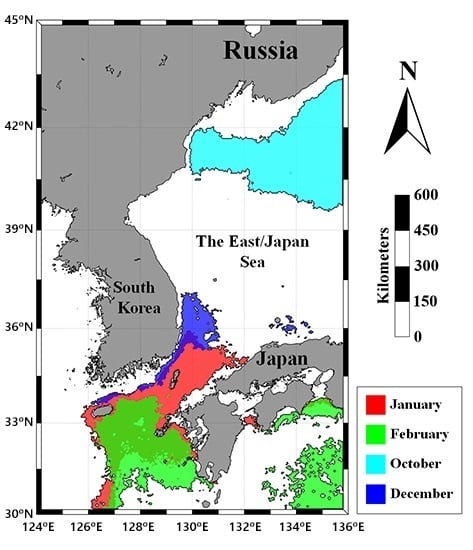Spatio-Temporal Variability of the Habitat Suitability Index for Chub Mackerel (Scomber Japonicus) in the East/Japan Sea and the South Sea of South Korea
Abstract
:1. Introduction
2. Materials and Methods
2.1. Fishery Data
2.2. Satellite Dataset
2.3. Habitat Suitability Index Model
3. Results
3.1. Preferred Environmental Conditions of the Chub Mackerel
3.2. Habitat Suitability Index Model Derivation
3.3. Habitat Suitability Index Model Evaluation
4. Discussion
4.1. Environmental Factors Affecting the Chub Mackerel
4.2. Seasonal Distribution of the HSI
4.3. Hotspot Analysis of the HSI
5. Summary and Conclusions
Author Contributions
Funding
Acknowledgments
Conflicts of Interest
References
- Collette, B.B.; Nauen, C.E. FAO Species Catalogue. Volume 2. Scombrids of the World. An Annotated and Illustrated Catalogue of Tunas, Mackerels, Bonitos and Related Species Known to Date; FAO: Rome, Italy, 1983. [Google Scholar]
- Kiparissis, S.; Tserpes, G.; Tsimenidis, N. Aspects on the Demography of Chub Mackerel (Scomber japonicus Houttuyn, 1782) in the Hellenic Seas. Belg. J. Zool. 2000, 130, 3–7. [Google Scholar]
- Hwang, S.; Kim, J.; Lee, T. Age, Growth, and Maturity of Chub Mackerel off Korea. N. Am. J. Fish. Manag. 2008, 28, 1414–1425. [Google Scholar] [CrossRef]
- Korea, S.; Korean Statistical Information Service (KOSIS). Fishery Production Survey; Korean Statistical Information Service (KOSIS): Daejeon, Korea, 2017. [Google Scholar]
- Choi, Y.; Zhang, C.; Lee, J.; Kim, J.; Cha, H. Stock Assessment and Management Implications of Chub Mackerel, Scomber japonicus in Korean Waters; Pukyong National University: Busan, Korea, 2003; pp. 10–13. [Google Scholar]
- Chyung, M. The Fishes of Korea; Il Ji Sa: Seoul, Korea, 1977. [Google Scholar]
- Yoon, S.; Kim, D.; Baeck, G.; Kim, J. Feeding Habits of Chub Mackerel (Scomber japonicus) in the South Sea of Korea. Korean J. Fish. Aquat. Sci. 2008, 41, 26–31. [Google Scholar] [CrossRef]
- NFRDI (National Fisheries Research and Development Institute). Ecology and Fishing Grounds for Some Major Fish in Korean Waters; National Fisheries Research and Development Institute: Busan, Korea, 2005.
- Parmesan, C.; Yohe, G. A Globally Coherent Fingerprint of Climate Change Impacts across Natural Systems. Nature 2003, 421, 37–42. [Google Scholar] [CrossRef] [PubMed]
- Perry, A.L.; Low, P.J.; Ellis, J.R.; Reynolds, J.D. Climate Change and Distribution Shifts in Marine Fishes. Science 2005, 308, 1912–1915. [Google Scholar] [CrossRef] [PubMed] [Green Version]
- Daskalov, G.M.; Grishin, A.N.; Rodionov, S.; Mihneva, V. Trophic Cascades Triggered by Overfishing Reveal Possible Mechanisms of Ecosystem Regime Shifts. Proc. Natl. Acad. Sci. USA 2007, 104, 10518–10523. [Google Scholar] [CrossRef] [PubMed]
- Jones, D.D.; Walters, C.J. Catastrophe Theory and Fisheries Regulation. J. Fish. Board Can. 1976, 33, 2829–2833. [Google Scholar] [CrossRef]
- Chen, X.; Li, G.; Feng, B.; Tian, S. Habitat Suitability Index of Chub Mackerel (Scomber japonicus) from July to September in the East China Sea. J. Oceanogr. 2009, 65, 93–102. [Google Scholar] [CrossRef]
- Hiyama, Y.; Yoda, M.; Ohshimo, S. Stock Size Fluctuations in Chub Mackerel (Scomber japonicus) in the East China Sea and the Japan/East Sea. Fish. Oceanogr. 2002, 11, 347–353. [Google Scholar] [CrossRef]
- Li, G.; Chen, X.; Lei, L.; Guan, W. Distribution of Hotspots of Chub Mackerel Based on Remote-Sensing Data in Coastal Waters of China. Int. J. Remote Sens. 2014, 35, 4399–4421. [Google Scholar] [CrossRef]
- Zheng, B.; Chen, X.; Li, G. Relationship between the Resource and Fishing Ground of Mackerel and Environmental Factors Based on GAM and GLM Models in the East China Sea and Yellow Sea. J. Fish. China 2008, 3, 007. [Google Scholar]
- Brooks, R.P. Improving Habitat Suitability Index Models. Wildl. Soc. Bull. (1973–2006) 1997, 25, 163–167. [Google Scholar]
- Galparsoro, I.; Borja, Á.; Bald, J.; Liria, P.; Chust, G. Predicting Suitable Habitat for the European Lobster (Homarus gammarus), on the Basque Continental Shelf (Bay of Biscay), using Ecological-Niche Factor Analysis. Ecol. Model. 2009, 220, 556–567. [Google Scholar] [CrossRef]
- Morris, L.; Ball, D. Habitat Suitability Modelling of Economically Important Fish Species with Commercial Fisheries Data. ICES J. Mar. Sci. 2006, 63, 1590–1603. [Google Scholar] [CrossRef]
- Rubec, P.J.; Bexley, J.C.; Norris, H.; Coyne, M.S.; Monaco, M.E.; Smith, S.G.; Ault, J.S. Suitability Modeling to Delineate Habitat Essential. In American Fisheries Society Symposium 22; American Fisheries Society: Bethesda, MD, USA, 1999; pp. 108–133. [Google Scholar]
- Vinagre, C.; Fonseca, V.; Cabral, H.; Costa, M.J. Habitat Suitability Index Models for the Juvenile Soles, Solea solea and Solea senegalensis, in the Tagus Estuary: Defining Variables for Species Management. Fish. Res. 2006, 82, 140–149. [Google Scholar] [CrossRef]
- Behrenfeld, M.J.; Falkowski, P.G. Photosynthetic Rates Derived from satellite-based Chlorophyll Concentration. Limnol. Oceanogr. 1997, 42, 1–20. [Google Scholar] [CrossRef]
- Yamada, K.; Ishizaka, J.; Nagata, H. Spatial and Temporal Variability of Satellite Primary Production in the Japan Sea from 1998 to 2002. J. Oceanogr. 2005, 61, 857–869. [Google Scholar] [CrossRef]
- Yen, K.; Lu, H.; Chang, Y.; Lee, M. Using Remote-Sensing Data to Detect Habitat Suitability for Yellowfin Tuna in the Western and Central Pacific Ocean. Int. J. Remote Sens. 2012, 33, 7507–7522. [Google Scholar] [CrossRef]
- Chen, X.; Feng, B.; Xu, L. A Comparative Study on Habitat Suitability Index of Bigeye Tuna, Thunnus obesus in the Indian Ocean. J. Fish. Sci. China 2008, 15, 269–278. [Google Scholar]
- Grebenkov, A.; Lukashevich, A.; Linkov, I.; Kapustka, L.A. A habitat suitability evaluation technique and its application to environmental risk assessment. In Ecotoxicology, Ecological Risk Assessment and Multiple Stressors; Springer: Berlin/Heidelberg, Germany, 2006; pp. 191–201. [Google Scholar]
- Hess, G.R.; Bay, J.M. A Regional Assessment of Windbreak Habitat Suitability. Environ. Monit. Assess. 2000, 61, 239–256. [Google Scholar] [CrossRef]
- Lauver, C.L.; Busby, W.H.; Whistler, J.L. Testing a GIS Model of Habitat Suitability for a Declining Grassland Bird. Environ. Manag. 2002, 30, 88–97. [Google Scholar] [CrossRef] [PubMed]
- Van der Lee, G.E.M.; Van der Molen, D.T.; Van den Boogaard, H.F.P.; Van der Klis, H. Uncertainty Analysis of a Spatial Habitat Suitability Model and Implications for Ecological Management of Water Bodies. Landsc. Ecol. 2006, 21, 1019–1032. [Google Scholar] [CrossRef]
- Kaschner, K.; Kesner-Reyes, K.; Garilao, C.; Rius-Barile, J.; Rees, T.; Froese, R. AquaMaps: Predicted Range Maps for Aquatic Species. World Wide Web Electronic Publication Version 08/2016. Available online: www.aquamaps.org (accessed on 3 April 2018).
- Castillo, J.; Barbieri, M.; Gonzalez, A. Relationships between Sea Surface Temperature, Salinity, and Pelagic Fish Distribution off Northern Chile. ICES J. Mar. Sci. 1996, 53, 139–146. [Google Scholar] [CrossRef]
- Jaureguizar, A.J.; Menni, R.; Guerrero, R.; Lasta, C. Environmental Factors Structuring Fish Communities of the Rıo de la Plata Estuary. Fish. Res. 2004, 66, 195–211. [Google Scholar] [CrossRef]
- Sutcliffe, W., Jr.; Drinkwater, K.; Muir, B. Correlations of Fish Catch and Environmental Factors in the Gulf of Maine. J. Fish. Board Can. 1977, 34, 19–30. [Google Scholar] [CrossRef]
- Smith, R.; Dustan, P.; Au, D.; Baker, K.; Dunlap, E. Distribution of Cetaceans and Sea-Surface Chlorophyll Concentrations in the California Current. Mar. Biol. 1986, 91, 385–402. [Google Scholar] [CrossRef]
- Lee, D.; An, Y.R.; Park, K.J.; Kim, H.W.; Lee, D.; Joo, H.T.; Oh, Y.G.; Kim, S.M.; Kang, C.K.; Lee, S.H. Spatial Distribution of Common Minke Whale (Balaenoptera acutorostrata) as an Indication of a Biological Hotspot in the East Sea. Deep Sea Res. Part II 2017, 143, 91–99. [Google Scholar] [CrossRef]
- Joo, H.T.; Son, S.; Park, J.W.; Kang, J.J.; Jeong, J.Y.; Lee, C.I.; Kang, C.K.; Lee, S.H. Long-Term Pattern of Primary Productivity in the East/Japan Sea Based on Ocean Color Data Derived from MODIS-Aqua. Remote Sens. 2016, 8, 25. [Google Scholar] [CrossRef]
- Cha, H.; Choi, Y.; Park, J.; Kim, J.; Sohn, M. Maturation and Spawning of the Chub Mackerel, Scomber japonicus Houttuyn in Korean Waters. J. Korean Soc. Fish. Res. 2002, 5, 24–33. [Google Scholar]
- Yasuda, T.; Yukami, R.; Ohshimo, S. Fishing Ground Hotspots Reveal Long-Term Variation in Chub Mackerel Scomber japonicus Habitat in the East China Sea. Mar. Ecol. Prog. Ser. 2014, 501, 239–250. [Google Scholar] [CrossRef]
- Nishimura, S. The Zoogeographical Aspects of the Japan Sea—Part II. Publ. Seto Mar. Biol. Lab. 1965, 13, 81–101. [Google Scholar] [CrossRef] [Green Version]
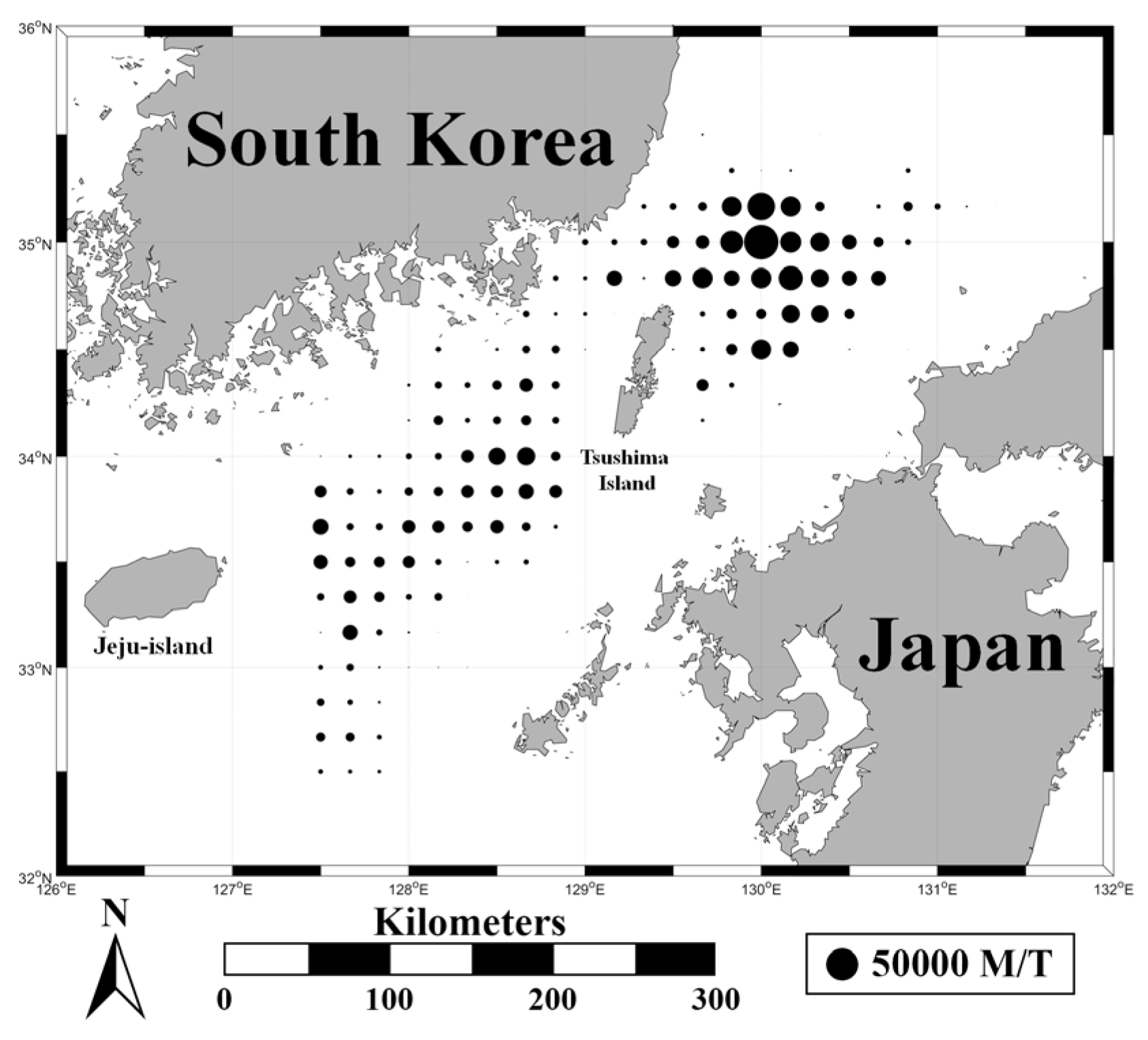
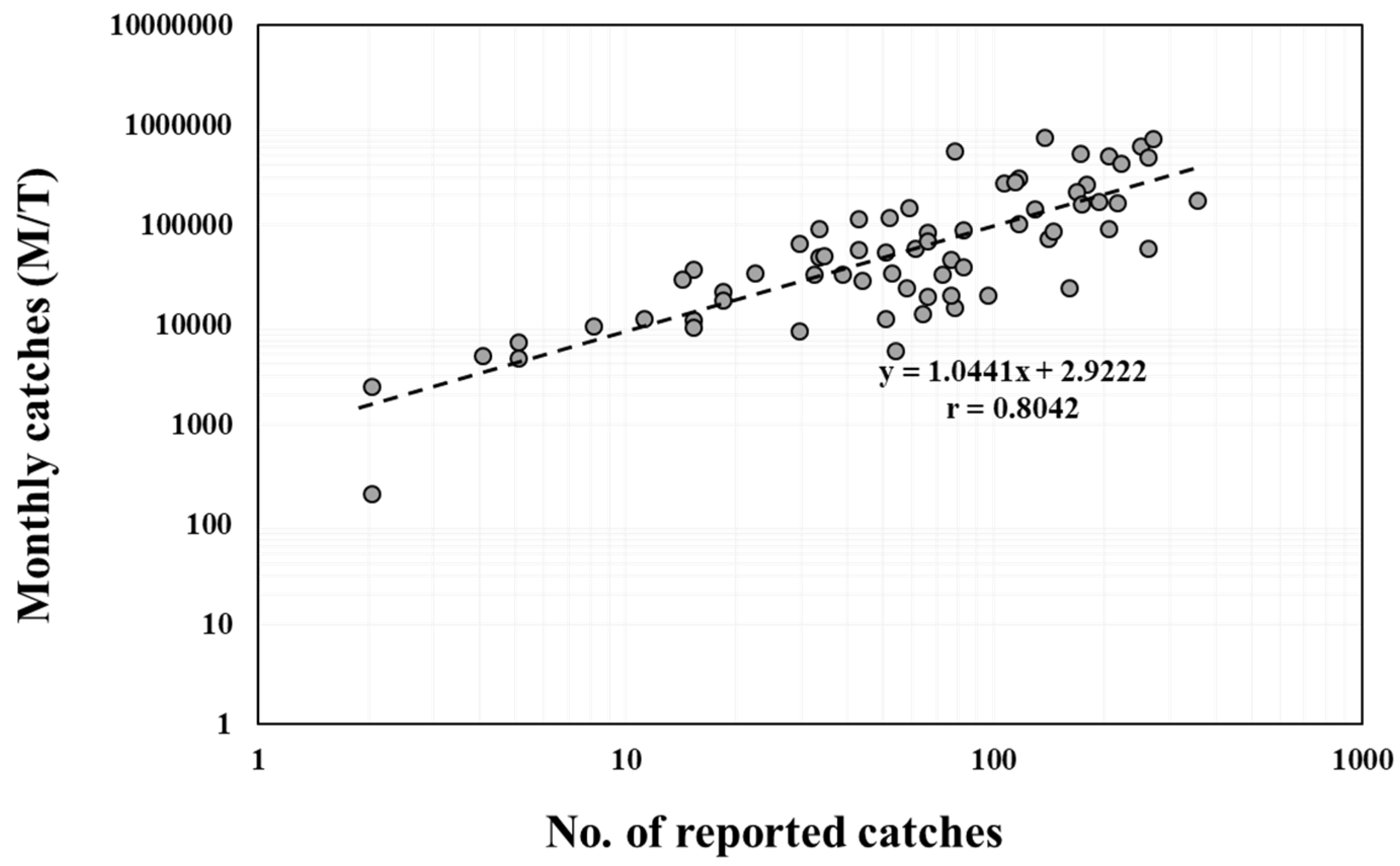

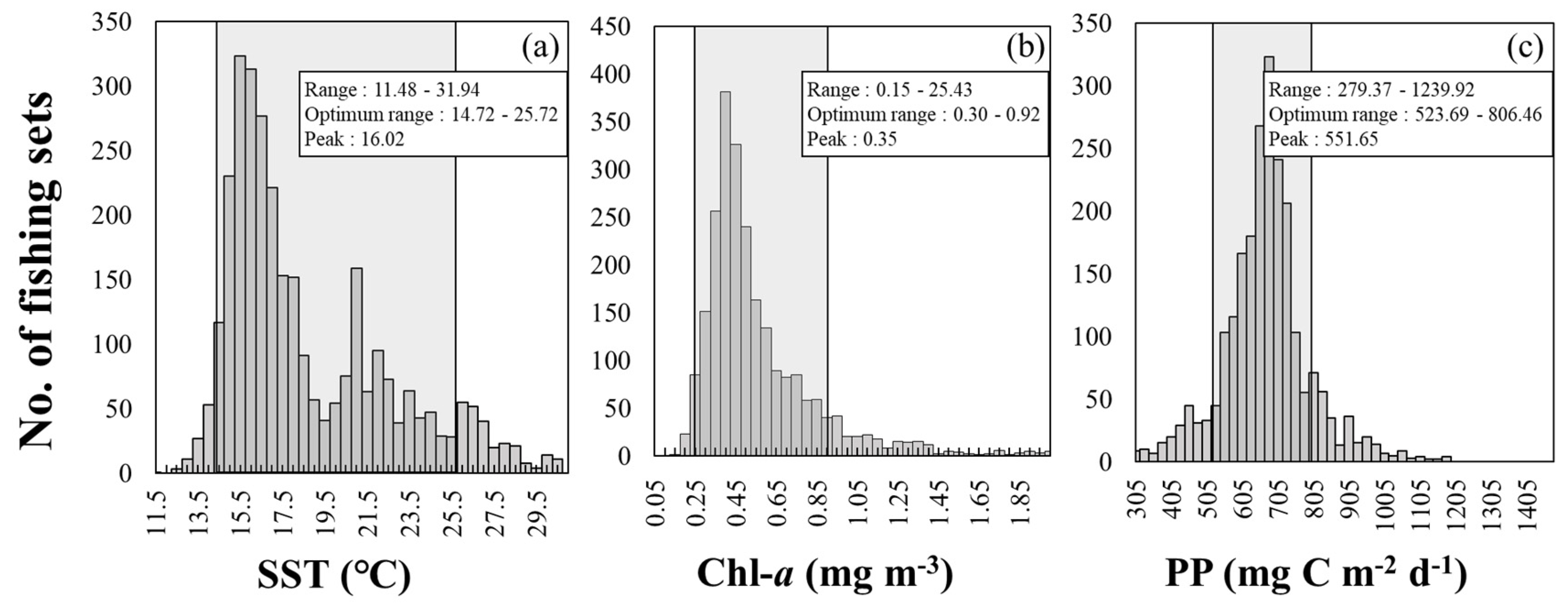
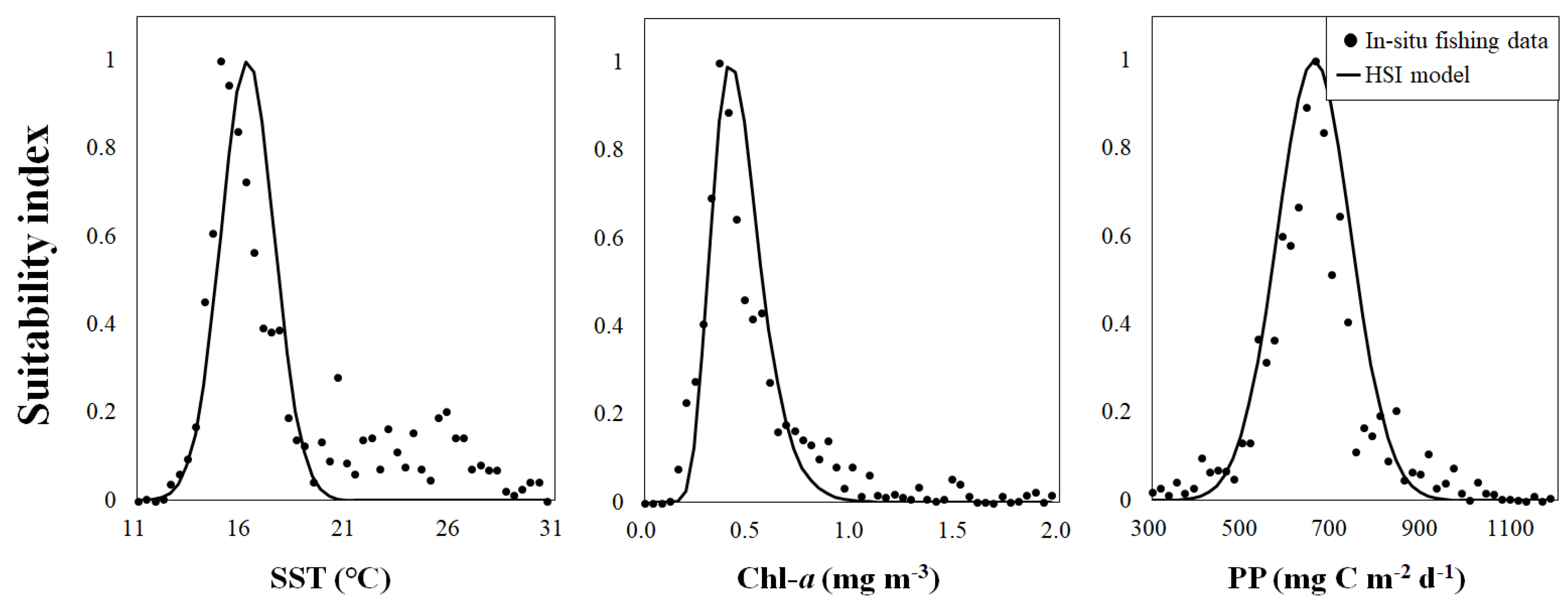
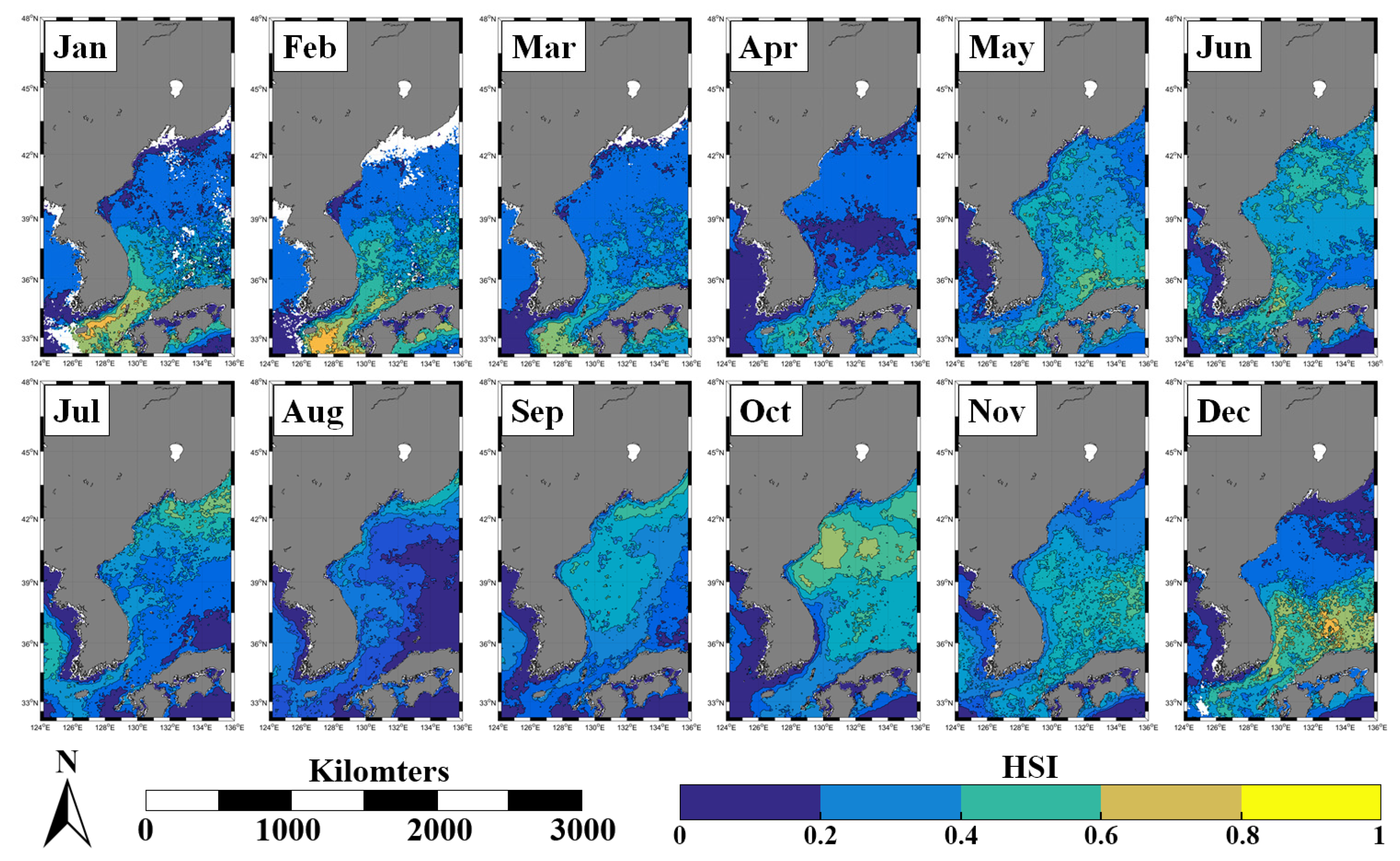
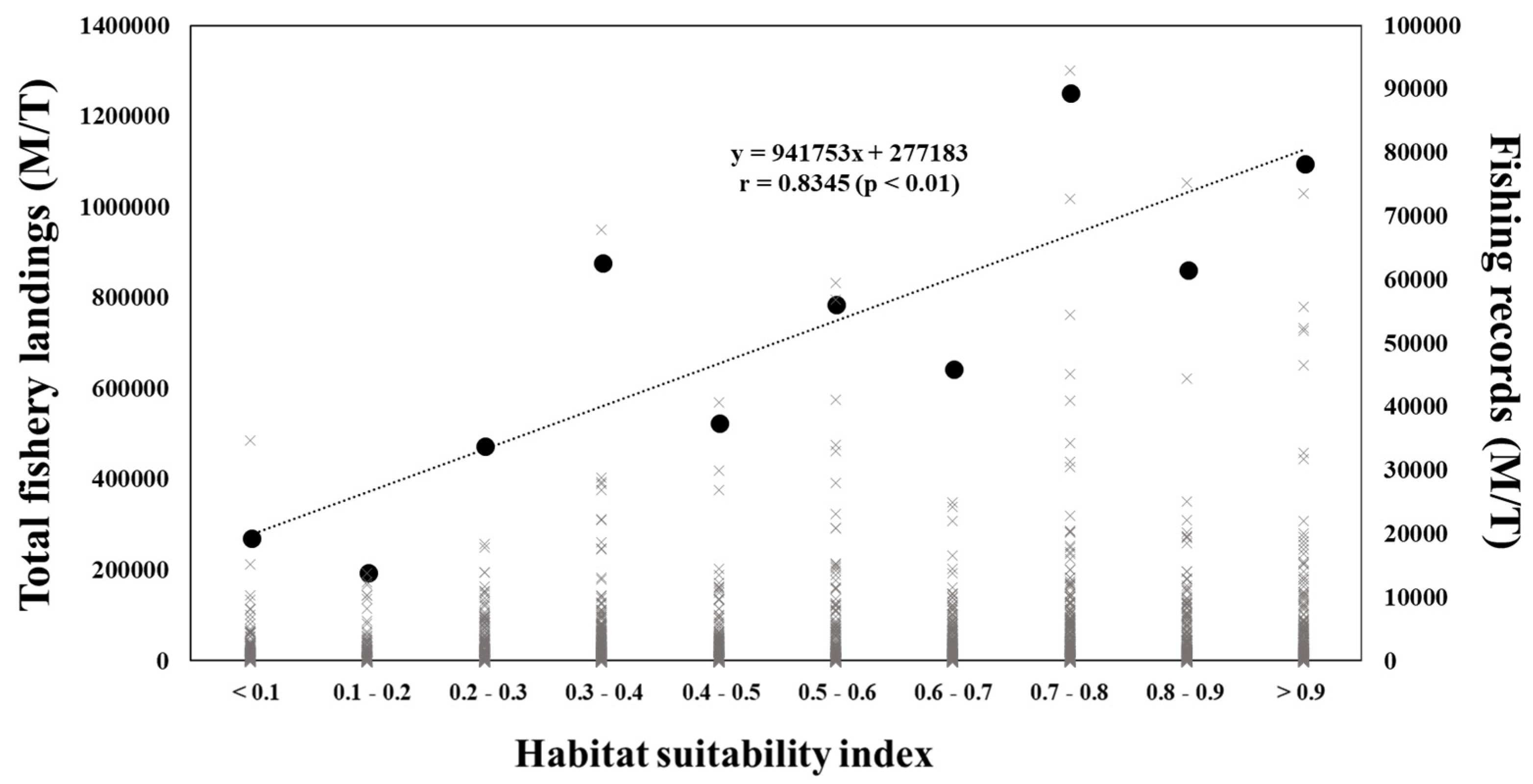
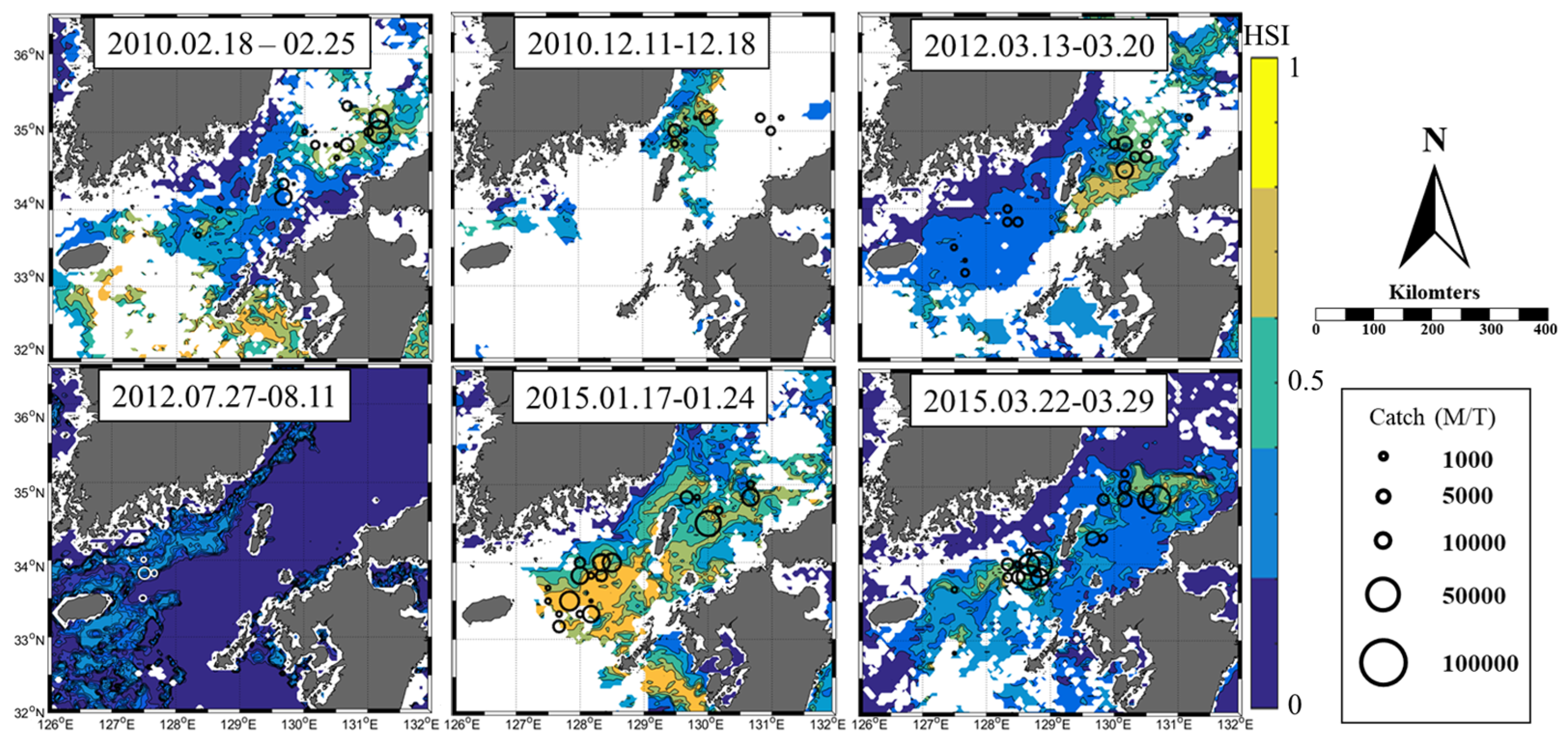

| Year | Reported Catches | No. of Matchable Catches |
|---|---|---|
| 2010 | 991 | 457 |
| 2012 | 789 | 336 |
| 2013 | 609 | 246 |
| 2014 | 809 | 277 |
| 2015 | 1715 | 586 |
| 2016 | 1144 | 407 |
| Total | 6057 | 2309 |
| Variables | SI Models | RMSE | R2 |
|---|---|---|---|
| SST | exp (−0.3034(XSST − 16.3)2) | 0.1440 | 0.6480 |
| Chl-a | exp(−6.963(ln(XChl) + 0.8782)2) | 0.0478 | 0.9325 |
| PP | exp(−0.00007347(XPP − 659.3)2) | 0.1211 | 0.8253 |
© 2018 by the authors. Licensee MDPI, Basel, Switzerland. This article is an open access article distributed under the terms and conditions of the Creative Commons Attribution (CC BY) license (http://creativecommons.org/licenses/by/4.0/).
Share and Cite
Lee, D.; Son, S.; Kim, W.; Park, J.M.; Joo, H.; Lee, S.H. Spatio-Temporal Variability of the Habitat Suitability Index for Chub Mackerel (Scomber Japonicus) in the East/Japan Sea and the South Sea of South Korea. Remote Sens. 2018, 10, 938. https://doi.org/10.3390/rs10060938
Lee D, Son S, Kim W, Park JM, Joo H, Lee SH. Spatio-Temporal Variability of the Habitat Suitability Index for Chub Mackerel (Scomber Japonicus) in the East/Japan Sea and the South Sea of South Korea. Remote Sensing. 2018; 10(6):938. https://doi.org/10.3390/rs10060938
Chicago/Turabian StyleLee, Dabin, SeungHyun Son, Wonkook Kim, Joo Myun Park, Huitae Joo, and Sang Heon Lee. 2018. "Spatio-Temporal Variability of the Habitat Suitability Index for Chub Mackerel (Scomber Japonicus) in the East/Japan Sea and the South Sea of South Korea" Remote Sensing 10, no. 6: 938. https://doi.org/10.3390/rs10060938




